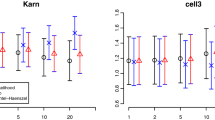Summary
The multinomial logistic response model has been used in the analysis of data from longitudinal studies of RERF's mortality cohort population. The model was restricted to linear and quadratic doseresponses for practical as well as biological reasons. The advantages and disadvantages of the multinomial logistic model are pointed out. Numerical comparison is made of the maximum likelihood (ML) estimates of parameters obtained by binomial and multinomial logistic procedures. The dose-response difference between two independent “same age” groups is evaluated from the ML estimates of parameters under a linear logistic response model. A significant dose-response difference between two independent “same age” groups in the years 1950–1959 and 1960–1969 is noted only for the 15–24 age group for all cancers other than leukemia.
Similar content being viewed by others
References
Ashford, J. R. (1959). An approach to the analysis of data for semi-quantal response in biological assay,Biometrics,15, 573–581.
Ashton, W. D. (1972)Logit transformation, Griffin, London.
Berkson, J. (1955). Maximum likelihood and minimumX 2 estimates of the logistic function.J. Amer. Statist. Ass.,50, 130–162.
Bock, R. D. (1970). Estimating multinomial response relations,Essays in Probability and Statistics (eds. Bose, R. C., Chakravarti, I. M., Mahalanobis, P. C., Rao, C. R. and Smith, K. J. C.), Chapel Hill, 111–132.
Chiang, C. L. (1968).Introduction to Stochastic Processes in Biostatistics, John Wiley, 242–268.
Cox, D. R. (1966). Some procedures connected with the logistic qualitative response curve,Research papers in Statistics: Essays in Honor of J. Neyman's 70th Birthday (ed. F. N. David), John Wiley, 55–71.
Cox, D. R. (1970).The Analysis of Binary Data, Methnen, London.
Fleiss, J. L. (1973).Statistical Methods for Rates and Proportions, John Wiley.
Gurland, J., Lee, I. and Dahn, P. A. 1960. Polychotomous quantal response in biological assay,Biometrics,16, 382–398.
Haberman, S. J. (1974).The Analysis of Frequency Data, The University of Chicago press.
Havid, H. A. (1970). On Chiang's proportionality assumption in the theory of competing risks,Biometrics,26, 336–339.
Jablon, S. and Kato, H. (1972). Studies of the mortality of A-bomb survivors. 5. Radiation dose and mortality, 1950–70,Radiat. Res.,48, 613–649.
Koch, G. G., Landis, J. R., Freeman, J. L., Freeman, D. H. and Lehnen, R. G. (1977). A general methodology for the analysis of experiments with repeated measurement of categorical data,Biometrics,33, 133–158.
Kudo, A. and Ito, K. (1974).Certain Statistical Methods in the Analysis of the effect of Inbreeding on Mortality, Paper presented at the 8th International Biometric Conference, Constanta, Romania, August 25–30.
Otake, M. (1976). Radiation effects on cancer mortality among A-bomb survivors, 1950–72: Comparison of some statistical models and analysis based on the additive logit model,J. Radiat. Res.,17, 262–321.
Stanish, W. M., Gillings, D. B. and Koch, G. G. (1978). An application of multivariate ratio methods for the analysis of a longitudinal clinical trial with missing data,Biometrics,34, 305–317.
Woolson, R. F., Leeper, J. D. and Clarks, W. R. (1978). Analysis of incomplete from longitudinal and mixed longitudinal studies.J. R. Statist. Soc., A,141, Part 2, 242–252.
Additional information
Radiation Effects Research Foundation
About this article
Cite this article
Otake, M. Comparison of time risks based on a multinomial logistic response model in longitudinal studies. Ann Inst Stat Math 32, 125–142 (1980). https://doi.org/10.1007/BF02480319
Received:
Revised:
Published:
Issue Date:
DOI: https://doi.org/10.1007/BF02480319




